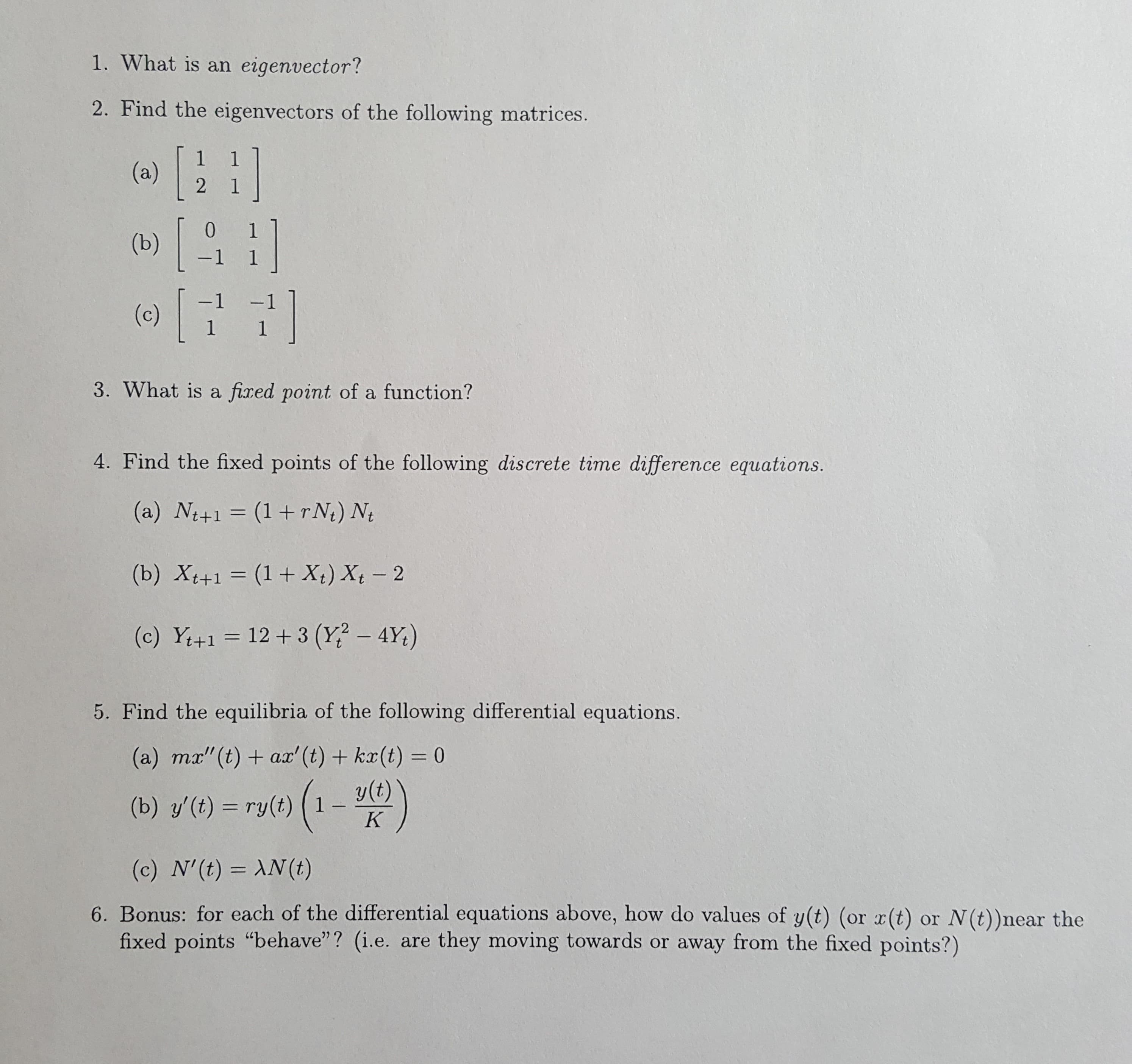1. What is an eigenvector? 2. Find the eigenvectors of the following matrices. (a) 2 1 [ 0 (b) -1 1 -1 (c) 1 1 3. What is a fixed point of a function? 4. Find the fixed points of the following discrete time difference equations. (a) Nt+1 (1+rN) Nt (b) Xt+1 (1 + X) Xt 2 12+3 (Y? - 4Y) (c) Y+1 5. Find the equilibria of the following differential equations. (a) mx"(t) ax' (t)+ kx(t) = 0 y(t) 1 (b) y'(t) ry(t) K (c) N'(t) AN (t) 6. Bonus: for each of the differential equations above, how do values of y(t) (or x(t) fixed points "behave"? (i.e. are they moving towards or away from the fixed points?) or N(t))near the
1. What is an eigenvector? 2. Find the eigenvectors of the following matrices. (a) 2 1 [ 0 (b) -1 1 -1 (c) 1 1 3. What is a fixed point of a function? 4. Find the fixed points of the following discrete time difference equations. (a) Nt+1 (1+rN) Nt (b) Xt+1 (1 + X) Xt 2 12+3 (Y? - 4Y) (c) Y+1 5. Find the equilibria of the following differential equations. (a) mx"(t) ax' (t)+ kx(t) = 0 y(t) 1 (b) y'(t) ry(t) K (c) N'(t) AN (t) 6. Bonus: for each of the differential equations above, how do values of y(t) (or x(t) fixed points "behave"? (i.e. are they moving towards or away from the fixed points?) or N(t))near the
Linear Algebra: A Modern Introduction
4th Edition
ISBN:9781285463247
Author:David Poole
Publisher:David Poole
Chapter4: Eigenvalues And Eigenvectors
Section4.6: Applications And The Perron-frobenius Theorem
Problem 70EQ
Related questions
Topic Video
Question
I need help for problem 5c. Thanks!

Transcribed Image Text:1. What is an eigenvector?
2. Find the eigenvectors of the following matrices.
(a)
2
1
[
0
(b)
-1 1
-1
(c)
1 1
3. What is a fixed point of a function?
4. Find the fixed points of the following discrete time difference equations.
(a) Nt+1 (1+rN) Nt
(b) Xt+1 (1 + X) Xt 2
12+3 (Y? - 4Y)
(c) Y+1
5. Find the equilibria of the following differential equations.
(a) mx"(t) ax' (t)+ kx(t) = 0
y(t)
1
(b) y'(t) ry(t)
K
(c) N'(t) AN (t)
6. Bonus: for each of the differential equations above, how do values of y(t) (or x(t)
fixed points "behave"? (i.e. are they moving towards or away from the fixed points?)
or N(t))near the
Expert Solution
This question has been solved!
Explore an expertly crafted, step-by-step solution for a thorough understanding of key concepts.
This is a popular solution!
Trending now
This is a popular solution!
Step by step
Solved in 3 steps with 3 images

Knowledge Booster
Learn more about
Need a deep-dive on the concept behind this application? Look no further. Learn more about this topic, algebra and related others by exploring similar questions and additional content below.Recommended textbooks for you

Linear Algebra: A Modern Introduction
Algebra
ISBN:
9781285463247
Author:
David Poole
Publisher:
Cengage Learning

Elementary Linear Algebra (MindTap Course List)
Algebra
ISBN:
9781305658004
Author:
Ron Larson
Publisher:
Cengage Learning

Linear Algebra: A Modern Introduction
Algebra
ISBN:
9781285463247
Author:
David Poole
Publisher:
Cengage Learning

Elementary Linear Algebra (MindTap Course List)
Algebra
ISBN:
9781305658004
Author:
Ron Larson
Publisher:
Cengage Learning